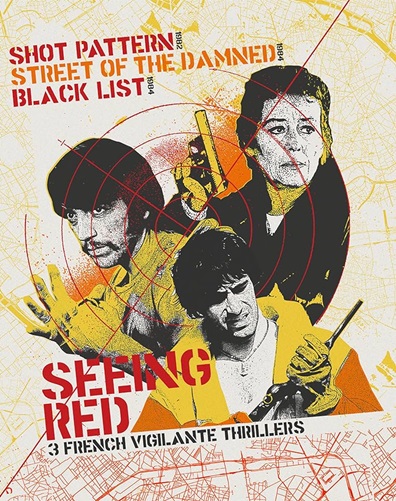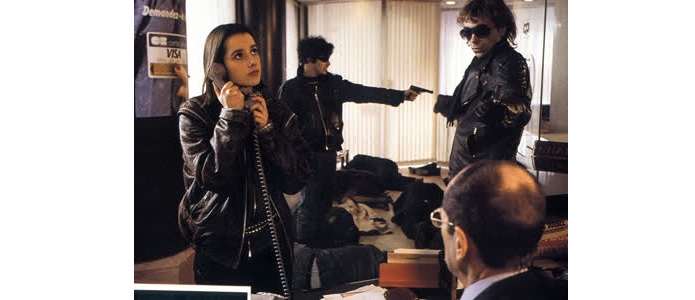
Seeing Red: 3 French Vigilante Thrillers
Studio: Fun City Editions
May 22, 2024
Web Exclusive
![]()
The United States was far from the only country that produced grimy vigilante thrillers in the ‘70s and ‘80s. You know the formula: an unnecessary tragedy befalls an innocent victim, flipping a switch that turns their once-peaceful parent/lover/associate into a pistol-packing angel of vengeance. Michael Winner’s vicious and internationally-successful Death Wish (1974) not only spawned a slew of sequels—Charles Bronson found himself avenging assorted loved ones into his early seventies—but inspired similar films around the globe. The French, of course, are no strangers to crime cinema, and this new, three-movie set from Fun City Editions brings three of their standout vigilante flicks from the early ‘80s to North American Blu-ray for the first time.
Shot Pattern (1982) follows down the path of Death Wish most closely, but defies the genre’s expectations in an interesting way. The opening feels a little like Michael Winner Lite™, but it’s brutal nonetheless: young perfumery clerk Carine (Véronique Jannot) is beaten and killed on a commuter train, leaving her grieving boyfriend Antoine (Gérard Lanvin) grasping for answers. While the cops carry out their exhaustive, slow-moving investigation, Antoine purchases a gun and starts pursuing his own leads. Rather than subject viewers to a predictable series of blood-soaked confrontations, what unfolds over most of Shot Pattern’s runtime are flashbacks to Antoine and Carine’s courtship. This goes a long way in humanizing our victim, making her into more than just an excuse for our hero to head off on his quest for vengeance. Their tragic love story, played out over vignettes, is more effective justification for the movie’s vigilante action than either of Death Wish or Death Wish II’s long, gratuitous rape scenes.
This is purely accidental, but Shot Pattern also follows in the Death Wish series’ happenstantial tradition of featuring a future star as one of its nameless hoodlums. Just as Jeff Goldblum, Lawrence Fishburne, Alex Winter, and Danny Trejo all stared down the barrel of Bronson’s gun early in their careers, one of Shot Pattern’s scumbags is played by future Jean-Pierre Jeunet favorite Dominique Pinon. (Shot Pattern also introduces its main characters in perhaps the most Eighties-tastic ways possible: we meet Antoine at the end of a slow pan around an arcade, and Carine during a dance aerobics class!)

Gilles Béhat’s Street of the Damned (1984) has the lowest-budget feel of the three included films, with its limited locations and long stretches without music. The story follows Chet (Bernard Giraudeau), a street tough turned good Samaritan, who stumbles across and helps a young girl after an assault. This pisses off Chet’s old boss, Hagen (Bernard-Pierre Donnadieu), a ganglord who effectively rules the neighborhood. Hagen nearly lets Chet off the hook for old time’s sake, but Chet won’t leave well enough alone when the mobster not only injures his pride, but imprisons the girl as his personal slave.
What Street of the Damned lacks in frills, it makes up for it with grit. Chet’s home is an urban hellscape where children gather around a junkyard bonfire to participate in preteen fight club; where 90% of the population are either prostitutes or thugs; where violent crimes are mundane occurrences. As for Chet, he shares a cramped apartment with his wife, junkie brother, hooker sister-in-law, and pervert dad. (The place is so dumpy that they can’t be bothered to paint over the obscene cartoon graffitied next to their front door.) While the extreme slummy-ness of the world is borderline comical, the place feels genuinely lived-in; almost every character has a shared history, whether it’s the way that Hagen’s goons revere Chet for his previous cruelties or how people fondly remember his washed-up brother’s brief career as a rock singer. In Street of the Damned, a hooker isn’t just a hooker—she’s Chet’s former grade school classmate. Conversations in this film play like friends reminiscing about the good old days at a high school reunion, except these reunions might happen at knifepoint in an abandoned factory.
With the over-the-top grunginess of this setting, the villains would also need to be next-level slimebags — and Street of the Damned does not disappoint in that regard. Hagen is a diet-conscious maniac who wears a white suit and his hair in tiny, double-decker ponytails. Even scuzzier is his primary enforcer, “Cobra,” a snakelike individual with the best throwing knife skills you’ll see outside of a Bond movie. (If this had instead been made by Nu Image in the early ‘90s, he’d surely have been played by Billy Drago.) The film culminates in a really well-choreographed karate showdown that would have been at home in one of Chuck Norris’ earlier, pre-Cannon efforts. Streets of the Damned might be the silliest movie of this trio, but it’s highly entertaining.

The final flick of the bunch is Black List (1984), which feels as if it were stitched together from two parts. The opening moves at a rapid pace, tracking three teenagers who are duped into sticking up a bank and serving as cover for a separate crew knocking over an armored truck nearby. The teens escape the police, but are no match for the professional criminals who made them into patsies. The second chunk of the film follows one teen’s grieving mother, Jeanne Dufour (Annie Girardot), as she deals out vigilante justice to the bad guys responsible for her child’s demise.
Black List begins with an absolutely riveting series of scenes, with the nerve-wracking situation unfolding from multiple angles. There’s the action inside the bank, with the kids realizing how hopeless their circumstances are; the cops trying to talk them down; the pros’ violent and well-planned strike on the delivery truck. And the fallout is equally intense – all the way through the mother and daughter’s final goodbyes (with some heartwrenching acting from both Girardot and Sandrine Dumas.) After this point, though, the pace slows down and it becomes your more predictable Death Wish-style vigilante tale, with a couple over-the-top kills. While the vigilante aspect of Black List isn’t quite as compelling as that of Streets of the Damned or Shot Pattern, it’s the best-looking movie of the pack (with probably the highest budget.) That said, we enjoyed it a lot–and might be judging its latter parts too strongly for not living up to its masterful first 30 minutes.

All three films make their North American Blu-ray debuts with strong audio-visual presentations and some nice bonus features. (All three movies feature commentaries by Travis Woods or Walter Chaw, and some assortment of archival interviews, trailers, image galleries, or—in Shot Pattern’s case—an alternate ending.) The booklet packs an informative essay by Euro Noir author Barry Forshaw, who provides context for these three movies within the larger history of French crime cinema.
Fans of Death Wish, Exterminator, and other ‘80s revenge films shouldn’t sleep on Seeing Red: 3 French Vigilante Thrillers. The set offers three distinct flavors of this sleazy little sub-genre, and is a really nice value at its price.
(www.funcityeditions.com/shop/p/seeingredbluray)
Current Issue

Issue #72
Apr 19, 2024 Issue #72 - The ‘90s Issue with The Cardigans and Thurston Moore
Most Recent
- 14 Best Songs of the Week: Nilüfer Yanya, Moses Sumney, Cassandra Jenkins, and More (News) —
- ForzaFest @ The Big Shed, Nottingham, UK, June 8, 2024 (Review) —
- The Gloss (Review) —
- Picture Parlour Unveil Debut EP “Face In The Picture” (News) —
- Rockaway Beach Announces First Artists For 2025 Edition (News) —

Comments
Submit your comment
There are no comments for this entry yet.